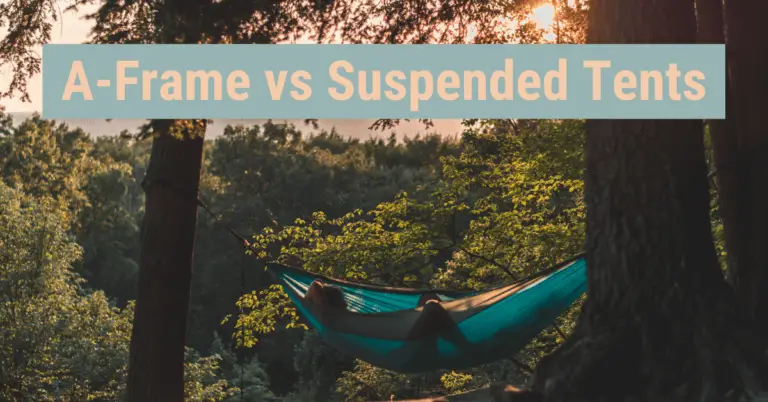When comparing an A-Frame tent vs suspended tents, they each offer low-weight options great for traveling campers but are suspended tents right for you?
We’ve broken down the major similarities and differences of common tent types to help you make the right decision for your next outdoor adventure!
A-Frame Tent vs Suspended Tent
First, let’s break down each type of tent:
Major Differences
The biggest difference between an A-frame tent vs suspended tent are where they can be used and their capacity. Suspended tents hang from trees or beams to create an enclosed hammock that will protect you from the elements anywhere you can find 2-3 trees. In contrast, A-frame tents use multiple poles to set up a shelter directly on the ground (the classic tent you’re likely thinking of). A-frames use poles on the front and back sides of the tent in combination with a pole across the top connecting the front and back to create the frame of the tent.
A-frames will have a higher peak height and allow you to stand on firm ground inside as opposed to getting in and out of the hammock tent. A-frames come in sizes of around 4 people at their largest while suspended tents max out at 2 people. Larger tent types can be found in different structural designs.
Both types of tents usually use a two-layer design to repel rain but an A-frame tent may be slightly more comfortable to spend a longer period of time inside during a storm as you can sit inside with more room easily compared to suspended tents.
Suspended tent’s largest advantage comes from their size and weight. Built specifically for backpacking, manufacturers can use minimal poles and fabric to get incredible low weights. If you have experience with hammocks or are comfortable setting up suspended tents, they can be perfect for your next backpacking trip. A-frame poles add a lot of weight and space that is tough to shrink down to stuff in your pack.
Best Uses For A-Frame & Suspended Tents
While A-frames can be used in any situation, they really shine in car camping with smaller groups. Suspended tents are absolutely the way to go (or specialized backpacking tents) to keep the weight low and pack size small. You can camp almost anywhere with a suspended tent, as long as you have trees nearby to hold your weight!
A-Frame | Suspended | |
Feature Comparison | A-Frame Tent vs Suspended Tent
Suspended tents and A-frame tents are very different from their general structure to their intended purpose and capacity. Suspended tents will run slightly more than the comparable A-frame for smaller space while A-frames can hold most of the family in any car-camping situation.
Given their differences, you’ll want to pick the one best suited for your next couple of years of camping plans!
Product | A-Frame | Suspended |
Sturdiness | ||
Capacity | ||
Cost | ||
Portability | ||
Ease of Setup |
Want more?
Check out our infographic and larger article covering the ten most common tent types or use our tent finding tool to quickly find the tents that suit your needs!
More A-Frame Tent Comparisons
➤ A-Frame Tent vs Backpacking Tent
➤ A-Frame Tent vs Suspended Tent







